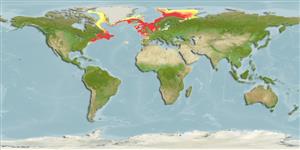>
Gadiformes (Cods) >
Lotidae (Hakes and burbots)
Etymology: Brosme: Greek, brosomai, bibrosko = to eat up, to devour (Ref. 45335).
Environment: milieu / climate zone / depth range / distribution range
экология
морской демерсальный; мигрирует в океане (Ref. 51243); пределы глубины 18 - 1000 m (Ref. 1371), usually 18 - 549 m (Ref. 1371). Temperate; 83°N - 37°N, 75°W - 57°E (Ref. 1371)
Northwest Atlantic: New Jersey to the Strait of Belle Isle and on the Grand Banks of Newfoundland. Rare at the southern tip of Greenland. Northeast Atlantic: off Iceland, in the northern North Sea, and along the coast of Scandinavia to the Murmansk Coast and at Spitzbergen.
Length at first maturity / Size / Вес / Возраст
Maturity: Lm 53.3, range 50 - ? cm
Max length : 120 cm TL самец/пол неопределен; (Ref. 9988); common length : 50.0 cm TL самец/пол неопределен; (Ref. 1371); наибольший вес (опубликованные данные): 30.0 kg (Ref. 9988); наибольший возраст (опубликованны данные): 20 годы (Ref. 1371)
колючие лучи спинного плавника (общее число): 0; членистые (мягкие) лучи спинного плавника (общее число): 93-103; членистые (мягкие) лучи анального плавника: 62 - 75; позвонки: 64 - 67. Barbel on present on chin, none on snout, its length equal to eye diameter. Color is variable; dorsally dark red-brown or green brown to yellow shading into pale color on belly. Young specimens may have six transverse yellow bands on sides. Vertical fins with dark margin rimmed with white.
Found in small shoals on rough, rock, gravel, or pebble bottoms. Generally keeps far from the shore, near the bottom, mostly between 150 and 450 m in the northeastern Atlantic, and between 18 and 550 m in the northwestern Atlantic. Occurs at a temperature range of 0°-10° C (Ref. 9988). Solitary or in small groups. Feeds on crustaceans and shellfishes, benthic fishes (flatfishes and gurnard) and even on starfishes. Preyed upon by seals (Ref. 9988). Sold fresh, frozen as fillets or dried salted. Eaten steamed, fried, broiled, boiled, microwaved and baked (Ref. 9988).
Spawns in shallower waters between 40-400 m, usually 100 to 200 m. Most important spawning grounds are located between Scotland and Iceland, from 200 to 500 m depth. In the Gulf of Maine, spawning grounds can be found in shallower waters (>50 m). Some individuals even spawn close inshore in Cape Cod, Provincetown Harbor and the Isles of Shoals (Ref. 1371).
Cohen, D.M., T. Inada, T. Iwamoto and N. Scialabba, 1990. FAO species catalogue. Vol. 10. Gadiform fishes of the world (Order Gadiformes). An annotated and illustrated catalogue of cods, hakes, grenadiers and other gadiform fishes known to date. FAO Fish. Synop. 125(10). Rome: FAO. 442 p. (Ref. 1371)
Статус Красного Списка МСОП (Ref. 130435)
Угроза для людей
Harmless
Использование человеком
рыболовство: важный объект промысла; объект спортивного рыболовства: да
дополнительная информация
ссылкиаквакультура (рыбоводство)особенности рыбоводствастепень растяжениягенетикаElectrophoresesнаследуемостьболезниобработкаNutrientsMass conversion
инструменты
Специальные отчеты
Скачать в формате XML
ресурсы в Интернет
Estimates based on models
Preferred temperature (Ref.
123201): 0.5 - 7.7, mean 3.6 °C (based on 726 cells).
Phylogenetic diversity index (Ref.
82804): PD
50 = 1.0000 [Uniqueness, from 0.5 = low to 2.0 = high].
Bayesian length-weight: a=0.00550 (0.00402 - 0.00751), b=3.09 (3.00 - 3.18), in cm total length, based on LWR estimates for this species (Ref.
93245).
Trophic level (Ref.
69278): 3.9 ±0.3 se; based on diet studies.
Generation time: 8.1 (6.8 - 11.1) years. Estimated as median ln(3)/K based on 13
growth studies.
устойчивость к внешним воздействиям (Ref.
120179): средний (среднего размера), минимальное время удвоения популяции 1.4-4.4 года (K=0.08-0.16; tm=8-10; tmax=20; Fec=2 million).
Prior r = 0.45, 95% CL = 0.30 - 0.68, Based on 7 stock assessments.
Fishing Vulnerability (Ref.
59153): High vulnerability (58 of 100).
Climate Vulnerability (Ref.
125649): Moderate vulnerability (44 of 100).
Nutrients (Ref.
124155): Calcium = 20.1 [10.6, 44.7] mg/100g; Iron = 0.308 [0.158, 0.657] mg/100g; Protein = 17.3 [15.5, 19.1] %; Omega3 = 0.376 [0.199, 0.688] g/100g; Selenium = 29.3 [14.7, 59.6] μg/100g; VitaminA = 11.1 [2.7, 41.5] μg/100g; Zinc = 0.364 [0.244, 0.562] mg/100g (wet weight);
